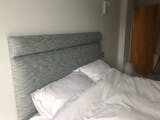As parents, we always want what's best for our children, especially when it comes to their sleep. One trend that has gained popularity in recent years is the use of a floor bed for infants and toddlers. Unlike traditional cribs, floor beds offer a unique approach to sleep that focuses on independence and mobility from a young age. But when is the right time to start using a floor bed for your child? In this blog, we will explore the benefits and considerations of using a floor bed and help you determine when it's the right time to make the switch.
Understanding the Floor Bed Concept
Before diving into when to start using a floor bed, it's essential to understand the concept behind it. A floor bed is essentially a mattress placed directly on the floor, without any crib bars or rails. The idea is to create a safe sleeping environment that allows your child to move freely, get in and out of bed independently, and explore their surroundings when they wake up.
Benefits of Using a Floor Bed
- Promotes Independence: One of the primary advantages of using a floor bed is that it promotes independence from a young age. Unlike a crib, which confines a child to a specific space, a floor bed allows them to learn how to get in and out of bed on their own. This independence can boost their confidence and self-esteem.
- Encourages Motor Development: Floor beds enable babies and toddlers to move freely, which can aid in the development of their gross and fine motor skills. Crawling, rolling, and exploring their surroundings while awake can contribute to their physical development.
- Supports Breastfeeding and Co-Sleeping: For parents who practice breastfeeding or co-sleeping, a floor bed can be a more convenient option. It allows for easy access to the child during night time feedings and encourages a closer bond between parent and child.
- Enhances Sleep Patterns: Many parents find that their children who sleep on floor beds have more regular sleep patterns. This might be because the child learns to self-soothe and regulate their sleep without the need for parental intervention.
- Smooth Transition to a Big Kid Bed: When it's time to transition from a crib to a larger bed, children who have been using a floor bed tend to adapt more easily. They are already accustomed to the freedom of movement and independence that a floor bed provides.

When to Start Using a Floor Bed
Now that we've explored the benefits of using a floor bed, let's discuss when it's the right time to start using one for your child. Keep in mind that every child is unique, and there is no one-size-fits-all answer. However, here are some general guidelines to consider:
- Around Six Months: Many parents begin transitioning their child to a floor bed around six months of age. At this point, most infants have developed sufficient neck and head control, reducing the risk of suffocation. Always ensure that your child can turn their head and breathe freely when using a floor bed.
- When They Show Signs of Mobility: If your child starts to show signs of crawling or rolling over, it may be a good time to introduce a floor bed. This way, they can explore their newfound mobility in a safe sleep environment.
- When They Outgrow the Crib: If your child has outgrown their crib or is consistently trying to climb out of it, it's time to consider a transition to a floor bed. Safety is paramount, and attempting to climb out of a crib can lead to accidents.
- When You Feel Comfortable: As a parent, you know your child best. If you feel comfortable and confident in making the switch to a floor bed, it's likely the right time. Trust your instincts and prioritize your child's safety and well-being.
Safety Considerations
When transitioning to a floor bed, safety is paramount. Here are some essential safety considerations:
- Babyproof the Room: Ensure the room where the floor bed is placed is babyproofed. Remove any hazards, secure furniture to the walls, and use outlet covers to prevent accidents.
- Use a Firm Mattress: Choose a firm mattress that fits snugly in the bed frame to reduce the risk of suffocation.
- Avoid Loose Bedding: Avoid using pillows, blankets, or stuffed animals in the bed to reduce the risk of suffocation. Instead, dress your child in appropriate sleepwear for the room's temperature.
- Maintain a Safe Sleeping Environment: Always place your baby on their back to sleep, as recommended by paediatricians. This reduces the risk of Sudden Infant Death Syndrome (SIDS).
- Supervise Early Exploration: While the floor bed promotes independence, it's essential to supervise your child's early exploration to ensure their safety.

Conclusion
Using a floor bed for your child can be a wonderful way to promote independence and create a safe sleep environment. The right time to start using a floor bed varies from child to child, but generally, it's when they show signs of mobility, outgrow the crib, or around six months of age. Always prioritize safety, babyproof the room, and follow recommended sleep guidelines to ensure a secure sleeping environment for your little one. Trust your instincts as a parent, and remember that the goal is to create a safe and nurturing space for your child to grow and develop.







